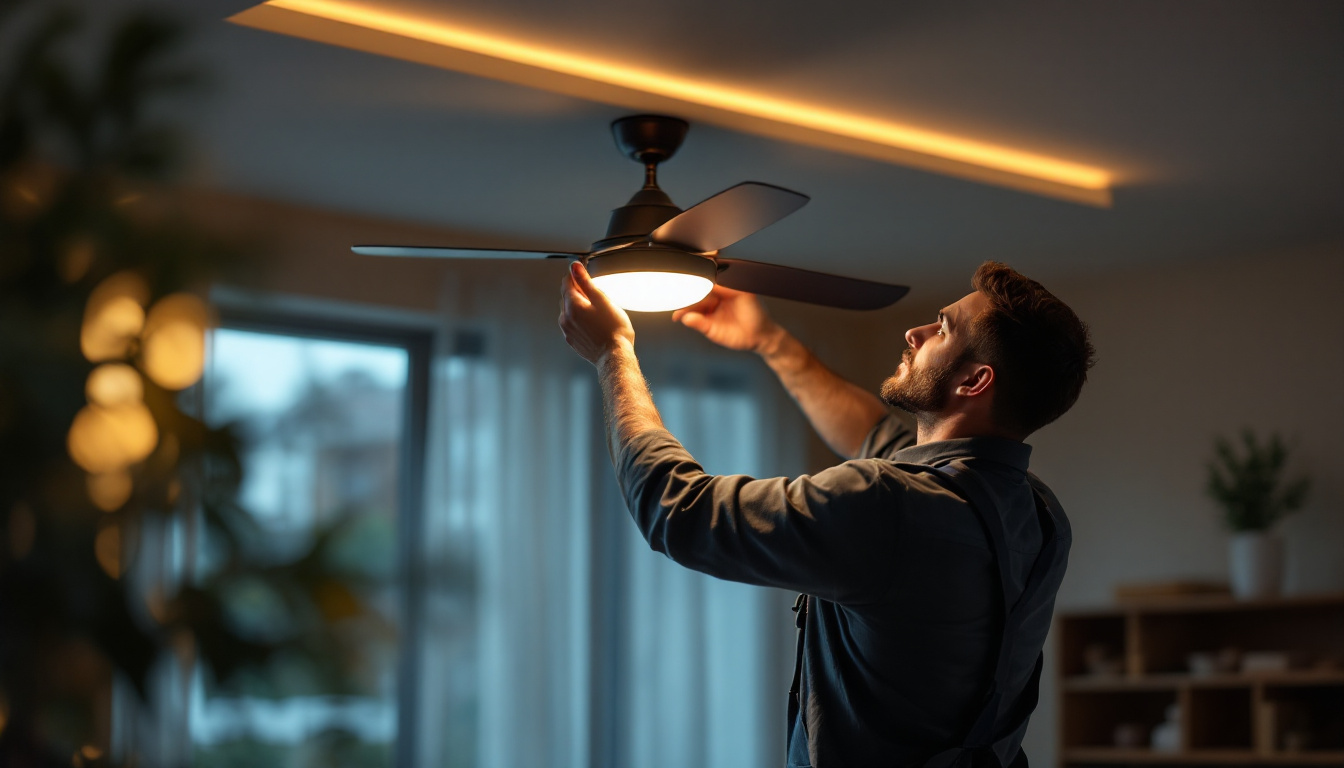
Ceiling fans have long been a staple in residential and commercial spaces, providing comfort and energy efficiency. However, with the rise of smart technology, these fixtures have evolved beyond their traditional roles. For lighting contractors, understanding how to integrate ceiling fans with smart lighting systems can enhance service offerings and improve client satisfaction. This article explores innovative hacks and strategies for smart lighting contractors working with ceiling fans.
Smart ceiling fans are designed to offer more than just airflow. They can be controlled via mobile apps, voice commands, or home automation systems, making them a versatile addition to any smart home setup. For lighting contractors, it’s essential to grasp the functionalities and benefits of these fans to effectively recommend them to clients. The growing trend towards smart home technology has made these fans not only a convenience but also a necessity for modern living, as they contribute to a more connected and efficient home environment.
Smart ceiling fans come equipped with a variety of features that enhance their usability. Many models allow users to adjust speed settings, change direction for seasonal airflow, and even set timers for automatic operation. These features not only improve comfort but can also contribute to energy savings, an attractive selling point for environmentally conscious clients. Additionally, some smart fans include built-in sensors that can detect room occupancy and adjust their operation accordingly, ensuring that energy is not wasted when a room is unoccupied. This level of automation not only adds convenience but also aligns with the increasing demand for energy-efficient home solutions.
One of the most significant advantages of smart ceiling fans is their ability to integrate seamlessly with existing smart home systems. Whether it’s through platforms like Google Home, Amazon Alexa, or Apple HomeKit, contractors can offer clients a cohesive smart home experience. This integration allows for synchronized control of lighting and ceiling fans, creating a more comfortable and energy-efficient environment. Furthermore, many smart ceiling fans can be programmed to respond to specific conditions, such as temperature changes or time of day, enhancing the overall functionality of the home. For example, a fan can be set to automatically turn on when the temperature rises above a certain threshold, providing immediate relief without the need for manual adjustments.
Installing smart ceiling fans requires a blend of electrical knowledge and an understanding of smart technology. Here are some essential tips to ensure a smooth installation process:
Before installation, it’s crucial to assess the existing electrical setup. Ensure that the ceiling box is rated for fan support, as many smart fans can be heavier than traditional models. Additionally, check for compatibility between the fan and the home’s electrical system, particularly if the fan includes smart features that require a neutral wire. It’s also wise to inspect the wiring for any signs of wear or damage, as outdated wiring can pose safety risks and hinder the fan’s performance. If the wiring is not up to code, it may be necessary to upgrade it before proceeding with the installation.
Smart ceiling fans rely on a stable Wi-Fi connection for optimal performance. During installation, contractors should verify that the fan’s location has adequate Wi-Fi coverage. If necessary, consider recommending Wi-Fi extenders to ensure reliable connectivity, which is essential for remote control and automation features. Additionally, it might be beneficial to discuss the potential for integrating the fan with other smart home devices, such as smart thermostats or lighting systems. This can create a more cohesive smart home experience, allowing users to control multiple devices from a single app, enhancing both convenience and energy efficiency.
Once installed, programming the fan to work with smart home systems is crucial. Contractors should familiarize themselves with the fan’s app and setup process, enabling them to assist clients in configuring their devices. Offering a brief tutorial on how to use the app can significantly enhance the client experience and build trust in the contractor’s expertise. Moreover, it’s important to highlight the various features available, such as scheduling, speed control, and integration with voice assistants like Alexa or Google Assistant. This not only empowers clients to make the most of their new technology but also encourages them to explore additional smart home options that can further enhance their living spaces.
Integrating smart ceiling fans into lighting projects can significantly enhance the overall client experience. Here are some strategies to consider:
Encouraging clients to customize their fan settings can lead to higher satisfaction. Many smart fans allow users to create personalized schedules based on their daily routines. For instance, a fan can be programmed to turn on in the morning to help circulate air and create a comfortable environment as the day warms up. Highlighting these features can demonstrate the added value of smart ceiling fans.
Educating clients about the energy-saving benefits of smart ceiling fans can be a game-changer. By using fans in conjunction with air conditioning, homeowners can set their thermostats a few degrees higher, reducing energy consumption. Providing clients with data on potential savings can make a compelling case for investing in smart technology.
Many clients appreciate the convenience of controlling their ceiling fans remotely. Whether they are at home or away, the ability to adjust settings from a smartphone app adds a layer of comfort and control. Contractors should emphasize this feature during consultations, as it can be a significant selling point for tech-savvy clients.
While smart ceiling fans offer numerous benefits, they can also present challenges during installation and use. Here are some common issues and their solutions:
One of the most frequent challenges with smart ceiling fans is connectivity. If a fan frequently disconnects from Wi-Fi, it can be frustrating for users. Contractors should recommend placing the fan within range of the router or utilizing mesh Wi-Fi systems to enhance coverage. Additionally, advising clients to regularly update their fan’s firmware can help maintain connectivity and performance.
Smart ceiling fans may not always be compatible with existing home automation systems. Before installation, contractors should verify compatibility with the client’s existing devices. If compatibility issues arise, solutions may include recommending specific smart hubs or suggesting alternative fan models that work seamlessly with the client’s system.
Clients may struggle with the technology behind smart ceiling fans, leading to frustration. Providing thorough education during the installation process can alleviate these concerns. Offering a user-friendly guide or a follow-up session to address questions can significantly enhance client satisfaction and foster a positive relationship.
For lighting contractors, effectively marketing smart ceiling fans can set a business apart from competitors. Here are some strategies to consider:
When creating marketing materials, it’s essential to highlight the benefits of smart ceiling fans. Use engaging visuals and clear messaging to convey features such as energy efficiency, convenience, and integration with smart home systems. Testimonials from satisfied clients can also add credibility and attract potential customers.
Social media platforms provide an excellent avenue for promoting smart ceiling fans. Sharing installation videos, tips, and client success stories can engage followers and showcase expertise. Additionally, consider running targeted ads to reach homeowners interested in upgrading their lighting and ceiling fan systems.
Building relationships with home automation specialists can lead to valuable referrals. Collaborating on projects that involve both lighting and smart ceiling fans can create a comprehensive solution for clients. Attend industry events and workshops to network with professionals in the home automation field, fostering partnerships that can benefit all parties involved.
The smart home industry is continually evolving, and ceiling fans are no exception. Staying informed about emerging trends can help contractors remain competitive and offer cutting-edge solutions to clients.
Future smart ceiling fans may incorporate advanced sensors that can detect occupancy and adjust settings accordingly. For instance, a fan could automatically turn on when someone enters a room and adjust its speed based on the ambient temperature. This level of automation enhances energy efficiency and convenience, making it a desirable feature for homeowners.
As technology advances, smart ceiling fans are likely to become more aesthetically pleasing and customizable. Manufacturers may offer a wider range of designs, colors, and materials to suit various interior styles. Contractors should stay updated on these trends to provide clients with options that align with their design preferences.
With an increasing focus on health and wellness, future smart ceiling fans may include features that promote better indoor air quality. This could involve integrating air purifiers or utilizing materials that reduce allergens. Contractors can position themselves as forward-thinking by offering solutions that prioritize the health and comfort of clients.
Smart ceiling fans present a unique opportunity for lighting contractors to enhance their service offerings and provide clients with innovative solutions. By understanding the features, installation processes, and marketing strategies associated with smart ceiling fans, contractors can position themselves as experts in the field. As technology continues to evolve, staying informed about trends and advancements will be crucial in maintaining a competitive edge. Embracing the future of smart ceiling fans not only benefits contractors but also elevates the overall client experience, leading to lasting relationships and successful projects.
Ready to elevate your lighting projects with the latest smart ceiling fan technology? Look no further than LumenWholesale for all your lighting needs. Our extensive selection of spec-grade lighting products is designed to meet the highest industry standards, ensuring you provide your clients with reliable and high-performance solutions. With unbeatable wholesale prices and the convenience of bulk buying without hidden fees, LumenWholesale is your go-to source for quality and affordability. Plus, with free shipping on bulk orders, you can save even more while delivering exceptional value to your clients. Take advantage of our superior lighting products and make your next project shine. Visit Wholesale Lighting at the Best Value and start transforming spaces with smart ceiling fans today.

Discover the essential compliance guidelines for RGB LED lights that every lighting contractor should know.

Discover the ultimate guide to T5 lights, exploring their benefits, applications, and how they can transform your lighting setup.

Discover how specialized artwork lighting fixtures can give lighting contractors a competitive edge.

Explore how gas station lights have evolved beyond their traditional role to become a key component in modern lighting solutions.